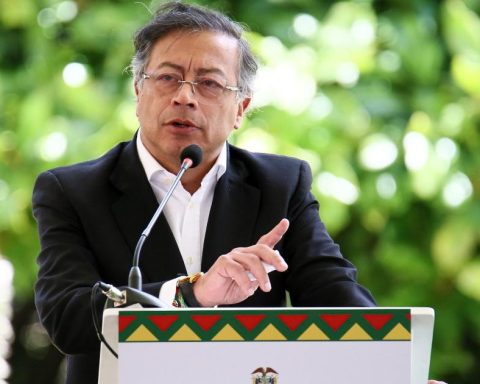The government of Gustavo Petro It intends to make a 180° turn in the Colombian labor, health and pension systems. The three reforms to the social security system have already been filed and one of the points that most different actors have questioned is the impact of these projects, both financial and sectoral.
(See: The Government’s response to the “worst Holy Week” in San Andrés).
In past days, the National Trade Union Council, headed by Germán Arce Zapata, sent a letter to the Government, in which it requested the Ministry of Finance to estimate the fiscal impact of the three reforms, simultaneously, in the medium and long term.
A joint estimate, however, could be difficult to achieve. According to José Ignacio López, director of economic research at Corficolombiana, “calculating the fiscal impact is a difficult task. Although there are some calculations and different government entities and think tanks have produced some numbers that will be key in the discussion in Congress”.
López points out that some research groups such as Fedesarrollo They are talking about the simultaneous impact of the labor and pension reform, which the Ministry of Finance also has some numbers and other research groups have also been doing calculations.
(See: Petro appoints four expert provisional commissioners in the Creg).
“Although they are approximations, they are very important. With the pension reform there is concern about the fiscal issue in the medium and long term and about domestic savings. In the other reforms there is less clarity, in labor there are some indirect costs, such as the government payroll, but there are also indirect effects on formalization and, therefore, the growth of the economy and taxes. In the health reform there are preliminary accounts of its costs”, he explained.
Of the three projects, The one that has generated the most criticism in relation to its costs is the pension reform.
Hence, the Center for Economic Studies Anif has submitted a report after the filing of the project. There it is stated thatthe high pension liability, which by itself today reaches a figure close to 110% of GDP, would more than double and would come to represent up to 249% of GDP”, with calculations to 2070. The Ministry of Finance came up against these accounts, which assured that, on the contrary, the project “can reduce between 7 and 12 percentage points of GDP the present value of the deficits of the contributory and semi-contributory pillars” of the pension system.
(See: ‘The EPS would be doomed to disappear in less than two years’).
According to the portfolio, With the implementation of the pension reform, the net present value by 2070 of the deficits could be reduced by 67.5% (in a scenario without reform), to 55.2% of GDP.
The executive director of Fedesarrollo, Luis Fernando Mejía, highlighted that the study center evaluated “the fiscal impact of the pension reform and the economic impact of the labor reform,” and acknowledged that “the fiscal impact of the health reform is difficult to right now because of the uncertainty about the basic elements.”
According to Mejia, heThe labor reform has no direct fiscal impact, but it can have an indirect one through its effects on informality and unemployment, such as lower tax collection and lower contributions to social security.
The estimated fiscal impact from Fedesarrollo for the pension reform, in the central scenario is an increase of 30.2 points of GDP in the liabilities of the old age protection system, with 12.5 points for the solidarity pillar; 8.4 points for the semi-contributory and 9.3 points for the contributory.
Fedesarrollo explained that the discrepancy with Anif and Minhacienda has to do with the fact that Anif, for example, includes in the calculation of the solidarity pillar people over 65 who belong to the groups of Sisben A, B and C, but according to Fedesarrollo, the Government has established a stricter classification criteria, which implies a difference of 200,000 people.
(See: Petro asks that workers be on the board of directors of Ecopetrol).
On the other hand, according to Fedesarrollo, the Ministry of Finance does not include in the cost of the reform the value of the solidarity pillar, which is the most expensive of all (12.5 points of GDP according to the entity’s calculations) and makes a calculation to 2070, while Fedesarrollo estimates it to the year 2100.
In the case of the labor reform, Fedesarrollo calculates that the increase in non-salary costs is due to the increase in dismissal costs. From there, Fedesarrollo estimated that only this measure would generate an increase in the informality of up 2.1 percentage points, equivalent to a loss of 460,000 formal jobs.
Fedesarrollo also calculated that the increase in labor costs as a result of the measures established by the reform would be 18.6% and that, with all this, a scenario could arise that combines a drop in micro-establishment sales, a reduction in employment and an increase in the price of the final good, which translates into inflation.

pension reform
The estimated costs for the health system
Despite the difficulties in calculating the fiscal impact of the projects, the Ministry of Finance delivered, at the end of February, the costing figures of the health reform project that was filed before Congress.
(See: OECD countries support pension and labor reforms, says the Government).
According to the portfolio, only in 2024 the fiscal expenses of the project would amount to $9.04 trillion. Of these, $5.49 trillion correspond to direct expenses, such as the Primary Health Care Centers (CAP), the strengthening of the Public Network, infrastructure expenses, scholarships, information system and hospital sanitation.
As for the remaining $3.54 trillion, these would refer to contingent expenses, in infrastructure and the capitalization of Nueva EPS.
LAURA LUCIA BECERRA ELEJALDE
Journalist Portfolio
















